#Matlab Neural Network Projects Help
Explore tagged Tumblr posts
Text
Exploring the Potential of Neural Networks In Matlab Projects
At Takeoff Edu Group, we are a team of experts that help beginners to explore the basics details of Neural Network Projects in MATLAB. The core of our curriculum is the combination of the theory with the practice, which allows students to be well-versed in the concept of neural networks. Participants acquire the necessary knowledge through practical projects. This learning process enables them to solve particular problems boldly. Solve the mysteries of Matlab and neural networks together with us to increase your expertise to the next level.
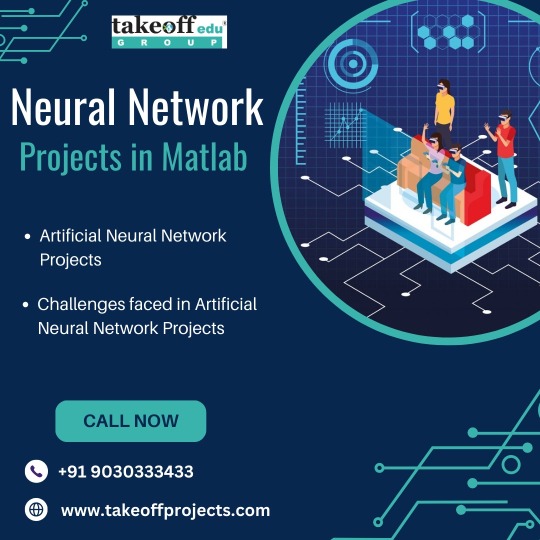
In Matlab Neural Networks Projects, potential users will be taught to use the Matlab programming language for the development and experimentation of artificial neural networks (ANNs). The neural networks are system of computers approved on mimicking the structure and function of the human brain. comprised of connected nodes called neurons, which process and spike the information.
In MATLAB users can develop neural networks in many forms, for example, feedforward neural networks, convolutional neural networks (CNNs), and recurrent neural networks (RNNs). This way they can be made to recognize complex patterns, to classify data, to make predictions and to do this or that.
The user-friendly interface and wide library of tools for the machine learning and deep learning in the Matlab package are one of the key advantages of using it for neural network data science projects. MATLAB functions, and algorithms for designing training and evaluating neural ensembles ensure accessibility to both experienced users and beginners.
Matlab provides a graphical interface through which a user can create models architecture, adjust parameters as well as gather performance level statistics to fine-tune the model. And on the other hand, Matlab assures the modularity of the neural networks with other techniques and algorithms thus allowing for interdisciplinary research and applications development.
Conclusion
In conclusion, Neural Network Projects in Matlab offered by Takeoff hold immense potential to revolutionize various industries. From improving image and speech recognition to aiding in medical diagnosis, financial forecasting, and autonomous systems, these projects span diverse applications. By harnessing the capabilities of Matlab, researchers and practitioners can unlock innovative solutions to complex problems. Takeoff provides a platform for individuals to delve into the realm of neural networks, fostering creativity and driving impactful advancements in their respective fields.
#Neural Network Projects Using Matlab#Matlab Neural Network Projects#Matlab Neural Network Projects Ideas#Matlab Neural Network Online Projects#Matlab Neural Network Projects Help
0 notes
Text
Expert AI and Machine Learning Dissertation Writing and Coding Services for UK Students
Are you working on a master’s dissertation in Artificial Intelligence (AI), Machine Learning (ML), Data Science, or Computer Science? Struggling with algorithm design, coding implementation, or structuring your thesis? At Tutors India, we offer specialized dissertation writing and editing services tailored for UK-based undergraduate and postgraduate students. Our expertise lies in supporting complex AI and ML dissertation projects—from ideation to execution.
Why Choose Our AI & ML Dissertation Coding Services in the UK?
Writing a master's dissertation that involves algorithmic modeling or machine learning implementation requires more than just technical know-how—it demands precision, clean code, academic rigor, and deep analytical thinking. Our Masters dissertation coding support ensures your research is not only technically robust but also aligned with your university’s academic standards.
Our Services Include:
Algorithm design and development
Machine learning model implementation
Python, R, MATLAB, and Java programming
Data preprocessing, modeling, and visualization
Dissertation writing, structuring, and academic editing
Proofreading and compliance with UK university guidelines
Complete Dissertation Development & Technical Support
Our full spectrum Master’s (Undergraduate) thesis development services guide you through every phase of your project:
Topic selection and proposal writing
Literature review synthesis
Research methodology design
Custom algorithm development and simulation
Technical documentation and results interpretation
Dissertation editing and formatting (APA, Harvard, etc.)
Whether you’re developing supervised learning algorithms, conducting time-series analysis, or building neural networks, our experienced developers and academic writers work hand-in-hand to ensure clarity, accuracy, and scholarly impact.
Specialized Algorithm Design and Optimization for Academic Projects
Our Algorithm Development Services UK are ideal for dissertations involving:
Predictive modeling
Optimization techniques
Deep learning architectures (CNNs, RNNs)
Data mining and feature selection
Reinforcement learning models
We ensure every algorithm is designed with academic integrity, documented with clarity, and tested for performance and accuracy. Whether your goal is to simulate real-world scenarios or derive new theoretical insights, we’ll help you engineer a solution that aligns with both academic and technical benchmarks.
Why UK Students Trust Tutors India
Proven expertise in AI/ML dissertation support
Technically proficient team of PhDs, data scientists, and software engineers
Customized, plagiarism-free content
Support across all UK universities and academic styles
24/7 academic consultation and revision handling
With years of experience in dissertation writing and editing services, Tutors India stands as a trusted academic and mentoring partner for students pursuing MSc, MEng, or MPhil dissertations in Artificial Intelligence, Data Analytics, and Machine Learning.
Start Your Dissertation Journey with Confidence
Don’t let coding complexities or technical writing challenges hinder your progress. With Tutors India, you receive more than just assistance—you gain a strategic partner committed to your academic excellence. Whether you need AI dissertation writing help, algorithm development guidance, or machine learning implementation support, we’re ready to assist you at every step.
Contact us today to get started on your Masters dissertation in AI or Machine Learning and secure the academic support you need to succeed.
0 notes
Text
Latest Trends in Automobile Engineering: EVs, AI & Autonomous Cars
The automobile industry is undergoing a massive transformation. With advancements in technology, the way vehicles are designed, manufactured, and operated is changing faster than ever before. From electric vehicles (EVs) to artificial intelligence (AI) and autonomous cars, innovation is driving the future of transportation. But what do these changes mean for aspiring engineers? Let's take a closer look at the latest trends shaping the industry.
Electric Vehicles (EVs) Are Taking Over
One of the most significant shifts in automobile engineering is the rise of electric vehicles. With concerns over pollution and the rising cost of fuel, EVs have become a viable alternative to traditional internal combustion engines. Companies like Tesla, Tata Motors, and Hyundai are investing heavily in EV technology, improving battery efficiency, and extending driving range.
For engineers, this means new opportunities in battery technology, power electronics, and sustainable design. Learning about lithium-ion batteries, charging infrastructure, and energy management systems can give students an edge in the field.
AI Integration in Automobiles
Artificial intelligence is playing a crucial role in making vehicles smarter. From voice assistants to predictive maintenance, AI is improving user experience and vehicle performance. Features like adaptive cruise control, lane departure warnings, and AI-powered diagnostics are becoming common in modern cars.
Engineers working in this domain need to understand machine learning, neural networks, and sensor integration. Skills in data analysis and software development are now essential for those aiming to contribute to AI-driven automobile innovations.
The Race for Autonomous Cars
Self-driving cars are no longer a concept from science fiction. Companies like Waymo, Tesla, and Mercedes-Benz are testing autonomous vehicles that can operate without human intervention. While fully self-driving cars are still in the testing phase, semi-autonomous features like self-parking and automated lane changing are already available.
To work in this sector, engineers must develop expertise in robotics, computer vision, and LiDAR technology. Understanding how different sensors interact to create a safe driving experience is key to developing autonomous systems.
What Are the Top 5 Engineering Colleges in Orissa?
With so many changes happening, students looking to enter the automobile industry should focus on gaining practical skills. Learning software like MATLAB, SolidWorks, and Ansys can be beneficial. Hands-on experience with automotive projects, internships, and research work can also help build a strong resume.
Those studying at the best engineering colleges in Odisha have the advantage of accessing quality labs, experienced faculty, and industry connections. Institutes like NMIET provide students with the resources needed to stay updated with industry trends and develop practical expertise.
Where to Study Automobile Engineering
With the growing demand for skilled professionals in this field, many students are looking for the best engineering colleges in Odisha to build their careers. A good college should offer state-of-the-art labs, strong placement support, and industry collaborations. Some institutions even have partnerships with automotive companies, providing students with direct exposure to the latest technologies.
The future of automobile engineering is exciting, and those who keep up with these trends will have plenty of opportunities ahead. Whether it's working on EVs, AI-powered vehicles, or autonomous technology, staying ahead of the curve is crucial. If you're passionate about cars and technology, now is the perfect time to explore these innovations and prepare for an exciting career ahead.
#best engineering colleges in bhubaneswar#best colleges in bhubaneswar#best engineering colleges in orissa#college of engineering and technology bhubaneswar#best engineering colleges in odisha#private engineering colleges in bhubaneswar#top 10 engineering colleges in bhubaneswar#college of engineering bhubaneswar#top 5 engineering colleges in bhubaneswar#"best private engineering colleges in odisha
0 notes
Text
MCA in AI: High-Paying Job Roles You Can Aim For

Artificial Intelligence (AI) is revolutionizing industries worldwide, creating exciting and lucrative career opportunities for professionals with the right skills. If you’re pursuing an MCA (Master of Computer Applications) with a specialization in AI, you are on a promising path to some of the highest-paying tech jobs.
Here’s a look at some of the top AI-related job roles you can aim for after completing your MCA in AI:
1. AI Engineer
Average Salary: $100,000 - $150,000 per year Role Overview: AI Engineers develop and deploy AI models, machine learning algorithms, and deep learning systems. They work on projects like chatbots, image recognition, and AI-driven automation. Key Skills Required: Machine learning, deep learning, Python, TensorFlow, PyTorch, NLP
2. Machine Learning Engineer
Average Salary: $110,000 - $160,000 per year Role Overview: Machine Learning Engineers build and optimize algorithms that allow machines to learn from data. They work with big data, predictive analytics, and recommendation systems. Key Skills Required: Python, R, NumPy, Pandas, Scikit-learn, cloud computing
3. Data Scientist
Average Salary: $120,000 - $170,000 per year Role Overview: Data Scientists analyze large datasets to extract insights and build predictive models. They help businesses make data-driven decisions using AI and ML techniques. Key Skills Required: Data analysis, statistics, SQL, Python, AI frameworks
4. Computer Vision Engineer
Average Salary: $100,000 - $140,000 per year Role Overview: These professionals work on AI systems that interpret visual data, such as facial recognition, object detection, and autonomous vehicles. Key Skills Required: OpenCV, deep learning, image processing, TensorFlow, Keras
5. Natural Language Processing (NLP) Engineer
Average Salary: $110,000 - $150,000 per year Role Overview: NLP Engineers specialize in building AI models that understand and process human language. They work on virtual assistants, voice recognition, and sentiment analysis. Key Skills Required: NLP techniques, Python, Hugging Face, spaCy, GPT models
6. AI Research Scientist
Average Salary: $130,000 - $200,000 per year Role Overview: AI Research Scientists develop new AI algorithms and conduct cutting-edge research in machine learning, robotics, and neural networks. Key Skills Required: Advanced mathematics, deep learning, AI research, academic writing
7. Robotics Engineer (AI-Based Automation)
Average Salary: $100,000 - $140,000 per year Role Overview: Robotics Engineers design and program intelligent robots for industrial automation, healthcare, and autonomous vehicles. Key Skills Required: Robotics, AI, Python, MATLAB, ROS (Robot Operating System)
8. AI Product Manager
Average Salary: $120,000 - $180,000 per year Role Overview: AI Product Managers oversee the development and deployment of AI-powered products. They work at the intersection of business and technology. Key Skills Required: AI knowledge, project management, business strategy, communication
Final Thoughts
An MCA in AI equips you with specialized technical knowledge, making you eligible for some of the most sought-after jobs in the AI industry. By gaining hands-on experience in machine learning, deep learning, NLP, and big data analytics, you can land high-paying roles in top tech companies, startups, and research institutions.
If you’re looking to maximize your career potential, staying updated with AI advancements, building real-world projects, and obtaining industry certifications can give you a competitive edge.
0 notes
Text
The Future of Image Processing Education: AI Integration and Beyond
In the rapidly evolving field of image processing, staying updated with the latest trends is crucial for students aiming to excel in this dynamic discipline. One of the most significant developments in recent years has been the integration of artificial intelligence (AI) techniques into image processing education. This paradigm shift is reshaping how students approach complex tasks such as image classification, object detection, and image enhancement. Let's delve into how these advancements are transforming the educational landscape and what it means for aspiring image processing professionals.
AI Integration in Image Processing Education
AI, particularly machine learning and deep learning algorithms, is revolutionizing image processing curricula across educational institutions worldwide. Traditionally focused on mathematical and algorithmic approaches, modern image processing courses now emphasize practical applications of AI. Students are learning to harness AI tools to automate tasks that were once labor-intensive and time-consuming. Techniques like neural networks are enabling breakthroughs in fields ranging from medical imaging to autonomous vehicle technology.
Cloud-Based Learning Platforms
Another trend gaining traction in image processing education is the adoption of cloud-based learning platforms. These platforms provide students with access to powerful computational resources and specialized software tools without the need for expensive hardware investments. Through cloud computing, students can experiment with large datasets, run complex algorithms, and collaborate on projects seamlessly. This approach not only enhances learning flexibility but also prepares students for real-world applications where cloud-based image processing solutions are increasingly prevalent.
Enhanced Learning Experiences with AR and VR
Augmented Reality (AR) and Virtual Reality (VR) technologies are transforming the classroom experience in image processing. These immersive technologies allow students to visualize complex algorithms in 3D, interact with virtual models of imaging systems, and simulate realistic scenarios. By bridging the gap between theory and practice, AR and VR enhance comprehension and retention of image processing concepts. Educators are leveraging these tools to create engaging learning environments that foster creativity and deeper understanding among students.
Ethical Considerations in Image Processing Education
As image processing technologies become more powerful, addressing ethical considerations is paramount. Educators are incorporating discussions on privacy, bias in algorithms, and societal impacts into the curriculum. By raising awareness about these issues, students are better equipped to navigate the ethical challenges associated with deploying image processing solutions responsibly.
How Our Service Can Help
Navigating through the complexities of image processing assignments can be challenging. At matlabassignmentexperts.com, we understand the importance of mastering these concepts while balancing academic responsibilities. Our team of experts is dedicated to providing comprehensive assistance tailored to your specific needs. Whether you need help with understanding AI algorithms for image classification or completing a challenging assignment on object detection, our experienced tutors are here to support you. Let us help you excel in your studies and confidently do your image processing assignment.
Conclusion
In conclusion, the future of image processing education is bright with innovations like AI integration, cloud-based learning, and immersive technologies reshaping the learning landscape. As students, embracing these advancements not only enhances your skillset but also prepares you for a rewarding career in fields where image processing plays a pivotal role. Stay informed, explore new technologies, and leverage resources like MATLAB Assignment Experts to achieve your academic and professional goals in image processing.
0 notes
Text
Artificial Neural Network Projects for Engineering Students
With a dedicated department of trainers and professional experts in AI/ML Deep Learning, Takeoff projects have helped successfully execute hundreds of projects in Artificial Neural Networks. We can successfully build your Artificial Neural Network Project from the ground-up, and execute and deliver it on time. Or we can also provide assistance and guidance for your current Neural Network Project to ensure its success. You can select one of the ANNs from our database to work with or have your own idea. Feel free to get in contact, and we will deliver your project within your pre-specified timeframe.

Latest Artificial Neural Network Projects:
Emotion Recognition System with Emotion Recognition System and EEG Sensors
Initial catching kidney disease by Electrocardiogram Signals through Machine Learning modalities modelling.
Schematics of a Bio-signal Stress Detection System Using Machine Learning Techniques Based on the Concept.
Trending Artificial Neural Network Projects:
Face Expression Recognition Approach Through Combing Multi-Factor Fusion and High-Order SVD
The role of ANN in stroke image classification like the other neural networks is principally based on learning.
The Particle Swarm Optimization comes up with the selection of the most winning features involved in Face Recognition.
Standard Artificial Neural Network Projects:
Tomato Classification Using Machine Learning Algorithms K-NN, MLP and the K-means algorithm (Coloration Mysticism Organelles)
Cancer of Brain Tumours Classification from MR Images based upon a Neural Network with the use of Central Moments
Artificial Neural Network Projects:
Have you even thought of a concept, deep learning, on which currently many data process without any kind of human intervention? Interestingly, an observable advancement is seen in the field of Artificial Neural Networks that also help the object recognition reach such a high accuracy. An artificial neural network which works just like the biological neurons in our nervous system is called a computational model of the real decision-making neuron network. It deals with those that are many and having the layers with the nodes that trick the one's functioning to the neuron in the brain.
Challenges faced in Artificial Neural Network Projects:
Thus, the existence of such an apparent contradiction that is between the beauty of technology and the fear of losing our people the way they are is the reason why the area of applications of Artificial Intelligence and other machine learning fields are implemented in our real lives. The greats and the concerns are a package deal. At the core, we have the powerful Artificial Neural Networks doing the calculations. If you are a student intending to works on Artificial Neural Network Projects and below is what you should do; visit Takeoff Projects for a practical exposure and development of your skill-set. Visit More information: https://takeoffprojects.com/neural-network-projects-in-matlab
#final year students projects#engineering students projects#academic projects#ai projects#Artificial Neural Network Projects#Academic Students Projects
0 notes
Note
an api for checking skins is at https://sessionserver.mojang.com/session/minecraft/profile/<UUID>
for example: https://sessionserver.mojang.com/session/minecraft/profile/68319ca7-db9d-4044-b142-f08580ca5c99
you could store that as a variable and check every so often. might go make that. i can feel the pull of my weird focus stuff
ohhh ok yeah here's what another anon sent:

that would make it a lot easier honestly. if either of you guys make a bot or script for this, please let me know!! i think it'd be very useful, especially if you're able to either make it a discord bot ppl could add or just link it to a tumblr account that makes a new post every time a skin is updated.
i know tumblr user @/timedeo has 2 tumblr accounts that’re run by a python bot to randomly generate posts based off of tubbo and timedeo’s tweets (@/tubbobot and @/deobot).
#anon#oakstar519#ty for the askkk :)#i can help? but idk how useful i'd be given the last time i had to code#was for a data science final project#made a fucking two layer neural network for sepsis prediction in like 4 days#slept maybe 6 hours during that period and i havent touched python since then#matlab my beloved#honestly itd be more useful than those twt accounts that track cc's spotify accts to see what they're listening to which is a little weird
17 notes
·
View notes
Text
Top 10 Python Libraries for Machine Learning
With the increase in the markets for smart products, auto-pilot cars and other smart products, the ML industry is on a rise. Machine Learning is also one of the most prominent tools of cost-cutting in almost every sector of industry nowadays.
ML libraries are available in many programming languages, but python being the most user-friendly and easy to manage language, and having a large developer community, is best suited for machine learning purposes and that's why many ML libraries are being written in Python.
Also, the python works seamlessly with C and C++ and so, the already written libraries in C/C++ can be easily extended to Python. In this tutorial, we will be discussing the most useful and best machine-learning libraries in the Python programming language.
1. TensorFlow :
Website: https://www.tensorflow.org/ GitHub Repository: https://github.com/tensorflow/tensorflow Developed By: Google Brain Team Primary Purpose: Deep Neural Networks TensorFlow is a library developed by the Google Brain team for the primary purpose of Deep Learning and Neural Networks. It allows easy distribution of work onto multiple CPU cores or GPU cores, and can even distribute the work to multiple GPUs. TensorFlow uses Tensors for this purpose.
Tensors can be defined as a container that can store N-dimensional data along with its linear operations. Although it is production-ready and does support reinforcement learning along with Neural networks, it is not commercially supported which means any bug or defect can be resolved only by community help.
2. Numpy:
Website: https://numpy.org/
Github Repository: https://github.com/numpy/numpy
Developed By: Community Project (originally authored by Travis Oliphant)
Primary purpose: General Purpose Array Processing
Created on the top of an older library Numeric, the Numpy is used for handling multi-dimensional data and intricate mathematical functions. Numpy is a fast computational library that can handle tasks and functions ranging from basic algebra to even Fourier transforms, random simulations, and shape manipulations. This library is written in C language, which gives it an edge over standard python built-in sequencing.
Numpy arrays are better than pandas series in the term of indexing and Numpy works better if the number of records is less than 50k. The NumPy arrays are loaded into a single CPU which can cause slowness in processing over the new alternatives like Tensorflow, Dask, or JAX, but still, the learning of Numpy is very easy and it is one of the most popular libraries to enter into the Machine Learning world.
3. Natural Language Toolkit (NLTK):
Website:
https://www.nltk.org/
Github Repository:https://github.com/nltk/nltk
Developed By: Team NLTK
Primary Purpose: Natural Language Processing
NLTK is the widely used library for Text Classification and Natural Language Processing. It performs word Stemming, Lemmatizing, Tokenization, and searching a keyword in documents. The library can be further used for sentiment analysis, understanding movie reviews, food reviews, text-classifier, checking and censoring the vulgarised words from comments, text mining, and many other human language-related operations.
The wider scope of its uses includes AI-powered chatbots which need text processing to train their models to identify and also create sentences important for machine and human interaction in the upcoming future.
4.Pandas
Website: https://pandas.pydata.org/ Github Repository: https://github.com/pandas-dev/pandas Developed By: Community Developed (Originally Authored by Wes McKinney) Primary Purpose: Data Analysis and Manipulation The Library is written in Python Web Framework and is used for data manipulation for numerical data and time series. It uses data frames and series to define three-dimensional and two-dimensional data respectively. It also provides options for indexing large data for quick search in large datasets. It is well known for the capabilities of data reshaping, pivoting on user-defined axis, handling missing data, merging and joining datasets, and the options for data filtrations. Pandas is very useful and very fast with large datasets. Its speed exceeds that of Numpy when the records are more than 50k.
It is the best library when it comes to data cleaning because it provides interactiveness like excel and speed like Numpy. It is also one of the few ML libraries that can deal with DateTime without any help from any external libraries and also with a bare minimum code with python code quality. As we all know the most significant part of data analysis and ML is the data cleaning, processing, and analyzing where Pandas helps very effectively.
5. Scikit-Learn:
Website: https://scikit-learn.org/
Github Repository: https://github.com/scikit-learn/scikit-learn
Developed By: SkLearn.org
Primary Purpose: Predictive Data Analysis and Data Modeling
Scikit-learn is mostly focused on various data modeling concepts like regression, classification, clustering, model selections, etc. The library is written on the top of Numpy, Scipy, and matplotlib. It is an open-source and commercially usable library that is also very easy to understand.
It has easy integrability which other ML libraries like Numpy and Pandas for analysis and Plotly for plotting the data in a graphical format for visualization purposes. This library helps both in supervised as well as unsupervised learnings.
6. Keras:
Website: https://keras.io/
Github Repository: https://github.com/keras-team/keras
Developed By: various Developers, initially by Francois Chollet
Primary purpose: Focused on Neural Networks
Keras provides a Python interface of Tensorflow Library especially focused on AI neural networks. The earlier versions also included many other backends like Theano, Microsoft cognitive platform, and PlaidMl.
Keras contains standard blocks of commonly used neural networks, and also the tools to make image and text processing faster and smoother. Apart from standard blocks of neural networks, it also provides re-occurring neural networks.
7. PyTorch:
Website: https://pytorch.org/
Github Repository: https://github.com/pytorch/pytorch
Developed By: Facebook AI Research lab (FAIR)
Primary purpose: Deep learning, Natural language Processing, and Computer Vision
Pytorch is a Facebook-developed ML library that is based on the Torch Library (an open-source ML library written in Lua Programming language). The project is written in
Python Web Development, C++, and CUDA languages. Along with Python, PyTorch has extensions in both C and C++ languages. It is a competitor to Tensorflow as both of these libraries use tensors but it is easier to learn and has better integrability with Python. Although it supports NLP, but the main focus of the library is only on developing and training deep learning models only.
8. MlPack:
Github Repository: https://github.com/mlpack/mlpack
Developed By: Community, supported by Georgia Institute of technology
Primary purpose: Multiple ML Models and Algorithms
MlPack is mostly C++-based ML library that has bindings to Python other languages including R programming, Julia, and GO. It is designed to support almost all famous ML algorithms and models like GMMs, K-means, least angle regression, Linear regression, etc. The main emphasis while developing this library was on making it a fast, scalable, and easy-to-understand as well as an easy-to-use library so that even a coder new to programming can understand and use it without any problem. It comes under a BSD license making it approachable as both open source and also proprietary software as per the need.
9. OpenCV:
Website: https://opencv.org/
Github Repository: https://github.com/opencv/opencv
Developed By: initially by Intel Corporation
Primary purpose: Only focuses on Computer Vision
OpenCV is an open-source platform dedicated to computer vision and image processing. This library has more than 2500 algorithms dedicated to computer vision and ML. It can track human movements, detect moving objects, extract 3d models, stitch images together to create a high-resolution image, exploring the AR possibilities.
It is used in various CCTV monitoring activities by many governments, especially in China and Israel. Also, the major camera companies in the world use OpenCv for making their technology smart and user-friendly.
10. Matplotlib:
Website: https://matplotlib.org/
Github Repository: https://github.com/matplotlib/matplotlib
Developed By: Micheal Droettboom, Community
Primary purpose: Data Visualization
Matplotlib is a library used in Python for graphical representation to understand the data before moving it to data-processing and training it for Machine learning purposes. It uses python GUI toolkits to produce graphs and plots using object-oriented APIs.
The Matplotlib also provides a MATLAB-like interface so that a user can do similar tasks as MATLAB. This library is free and open-source and has many extension interfaces that extend matplotlib API to various other libraries.
Conclusion:
In this blog, you learned about the best Python libraries for machine learning. Every library has its own positives and negatives. These aspects should be taken into account before selecting a library for the purpose of machine learning and the model’s accuracy should also be checked after training and testing the models so as to select the best model in the best library to do your task.
Also Read:
Unit Testing Frameworks in Python
0 notes
Text
Learn About Different Tools Used in Data Science
Data Science is a very broad spectrum and all its domains need data handling in unique way which get many analysts and data scientists into confusion. If you want to be pro-active in finding the solution to these issues, then you must be quick in making decision in choosing the right tools for your business as it will have a long-term impact.
This article will help you have a clear idea while choosing the best tool as per your requirements.
Let's start with the tools which helps in reporting and doing all types of analysis of data analytic and getting over to dashboarding. Some of the most common tools used in reporting and business intelligence (BI) are as follows:
- Excel: In this you get wide range of options which includes Pivot table and charts, with which you can do the analysis more quickly and easily.
- Tableau: This is one of the most popular visualization tools which is also capable of handling large amounts of data. This tool provides an easy way to calculate functions and parameters, along-with a very neat way to present it in a story interface.
- PowerBI: Microsoft offers this tool in its Business Intelligence (BI) Space, which helps in integrations of Microsoft technologies.
- QlikView: This is also a very popular tool because it’s easy to learn and is also a very intuitive tool. With this, one can integrate and merge, search, visualize and analyse all the sources of data very easily.
- Microstrategy: This BI tool also supports dashboards, key data analytics tasks like other tools and automated distributions as well.
Apart from all these tools, there is one more which you cannot exclude from this tool's list, and that tool is
- Google Analytics: With google analytics, you can easily track all your digital efforts and what role they are playing. This will help in improvising your strategy.
Now let's get to the part where most of the data scientists deal with. The following predictive analytics and machine learning tools will help you solve forecasting, statistical modelling, neural networks and deep learning.
- R: It is very commonly used language in data science. You can access its libraries and packages as they are easily available. R has also a very strong community which will you if you got with something.
- Python: This is also one of the most common language for data science, or you can also say that this is one the most used language for data science. It is an open-source language which makes it favourite among data scientists. It has gained a good place because of its ease and flexibility.
- Spark: After becoming open source, it has become one of the largest communities in the world of data. It holds its place in data analytics as it offers features of flexibility, computational power, speed, etc.
- Julia: This is a new and emerging language which is very similar to Python along-with some extra features.
- Jupyter Notebooks: This is an open-source web application widely used in Python for coding. It is mainly used in Python, but it also supports R, Julia etc.
Apart from all these widely used tools, there are some other tools of the same category that are recognized as industry leaders.
- SAS
- SPSS
- MATLAB
Now let's discuss about the data science tools for Big Data. But to truly understand the basic principles of big data, we will categorize the tools by 3 V's of big data:
· Volume
· Variety
· Velocity
Firstly, let's list the tools as per the volume of the data.
Following tools are used if data range from 1GB to 10GB approx.:
- Microsoft Excel: Excel is most popular tool for handling data, but which are in small amounts. It has limitations of handling up to 16,380 columns at a time. This is not a good choice when you have big data in hand to deal with.
- Microsoft Access: This is also another tool from Microsoft in which you handle databases up to 2 Gb, but beyond that it will not be able to handle.
- SQL: It has been the primary database solution from last few decades. It is a good option and is most popular data management system but, it still has some drawbacks and become difficult to handle when database continues to grow.
- Hadoop: If your data accounts for more than 10Gb then Hadoop is the tool for you. It is an open-source framework that manages data processing for big data. It will help you build a machine learning project from starting.
- Hive: It has a SQL-like interface built on Hadoop. It helps in query the data which has been stored in various databases.
Secondly, let's discuss about the tools for handling Variety
In Variety, different types of data are considered. In all, data are categorized as Structured and Unstructured data.
Structured data are those with specified field names like the employee details of a company or a school database or the bank account details.
Unstructured data are those type of data which do not follow any trend or pattern. They are not stored in a structured format. For example, the customer feedbacks, image feed, video fee, emails etc.
It becomes really a difficult task while handling these types of data. Two most common databases used in managing these data are SQL and NoSQL.
SQL has been a dominant market leader from a long time. But with the emergence of NoSQL, it has gained a lot of attention and many users have started adopting NoSQL because of its ability to scale and handle dynamic data.
Thirdly, there are tools for handling velocity.
It basically means the velocity at which the data is captured. Data could be both real time and non-real time.
A lot of major businesses are based on real-time data. For example, Stock trading, CCTV surveillance, GPS etc.
Other options include the sensors which are used in cars. Many tech companies have launched the self-driven cars and there are many high-tech prototypes in cue to be launched. Now these sensors need to be in real-time and very quick to dynamically collect and process data. The data could be regarding the lane, it could be regarding the GPS location, it could be regarding the distance from other vehicles, etc. All these data need to be collected and processed at the same time.
So, for these types of data following tools are helping in managing them:
- Apache Kafka: This is an open-source tool by Apache and is quick. One good feature of this tool is that this is fault-tolerant because of which this is used in production in many organisations.
- Apache Storm: This is another tool from Apache which can used with most of the programming language. It is considered very fast and good option for high data velocity as it can process up to 1 Million tuples/second.
- Apache Flink: This tool from Apache is also used to process real-time data. Some of its advantages are fault-tolerance, high performance and memory management.
- Amazon Kinesis: This tool from Amazon is a very powerful option for organizations which provides a lot of options, but it comes with a cost.
We have discussed about almost all the popular tools available in the market. But it’s always advisable to contact some data science consulting services to better understand the requirements and which tool will be best suitable for you.
Look for the best data science consulting company which would best suit in your requirements list.
#data science#data science consulting services#best data science consulting company#data science consultant
5 notes
·
View notes
Text
How to Find a Perfect Deep Learning Framework
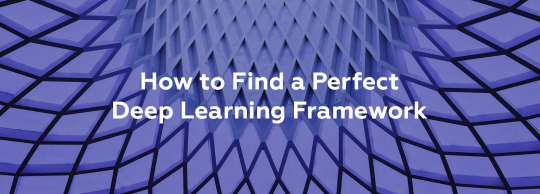
Many courses and tutorials offer to guide you through building a deep learning project. Of course, from the educational point of view, it is worthwhile: try to implement a neural network from scratch, and you’ll understand a lot of things. However, such an approach does not prepare us for real life, where you are not supposed to spare weeks waiting for your new model to build. At this point, you can look for a deep learning framework to help you.
A deep learning framework, like a machine learning framework, is an interface, library or a tool which allows building deep learning models easily and quickly, without getting into the details of underlying algorithms. They provide a clear and concise way for defining models with the help of a collection of pre-built and optimized components.
Briefly speaking, instead of writing hundreds of lines of code, you can choose a suitable framework that will do most of the work for you.
Most popular DL frameworks
The state-of-the-art frameworks are quite new; most of them were released after 2014. They are open-source and are still undergoing active development. They vary in the number of examples available, the frequency of updates and the number of contributors. Besides, though you can build most types of networks in any deep learning framework, they still have a specialization and usually differ in the way they expose functionality through its APIs.
Here were collected the most popular frameworks
TensorFlow

The framework that we mention all the time, TensorFlow, is a deep learning framework created in 2015 by the Google Brain team. It has a comprehensive and flexible ecosystem of tools, libraries and community resources. TensorFlow has pre-written codes for most of the complex deep learning models you’ll come across, such as Recurrent Neural Networks and Convolutional Neural Networks.
The most popular use cases of TensorFlow are the following:
NLP applications, such as language detection, text summarization and other text processing tasks;
Image recognition, including image captioning, face recognition and object detection;
Sound recognition
Time series analysis
Video analysis, and much more.
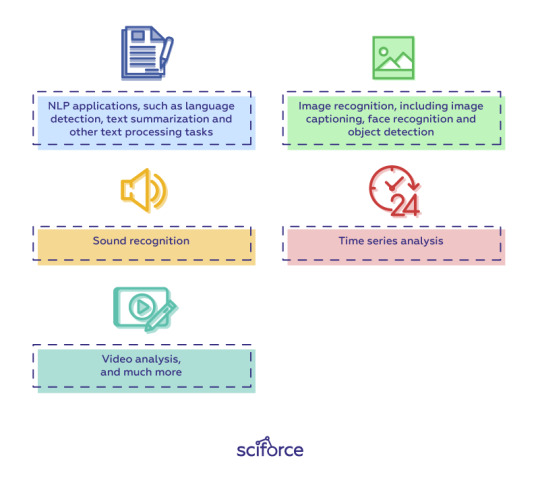
TensorFlow is extremely popular within the community because it supports multiple languages, such as Python, C++ and R, has extensive documentation and walkthroughs for guidance and updates regularly. Its flexible architecture also lets developers deploy deep learning models on one or more CPUs (as well as GPUs).
For inference, developers can either use TensorFlow-TensorRT integration to optimize models within TensorFlow, or export TensorFlow models, then use NVIDIA TensorRT’s built-in TensorFlow model importer to optimize in TensorRT.
Installing TensorFlow is also a pretty straightforward task.
For CPU-only:
pip install tensorflow
For CUDA-enabled GPU cards:
pip install tensorflow-gpu
Learn more:
An Introduction to Implementing Neural Networks using TensorFlow
TensorFlow tutorials
PyTorch

PyTorch
Facebook introduced PyTorch in 2017 as a successor to Torch, a popular deep learning framework released in 2011, based on the programming language Lua. In its essence, PyTorch took Torch features and implemented them in Python. Its flexibility and coverage of multiple tasks have pushed PyTorch to the foreground, making it a competitor to TensorFlow.
PyTorch covers all sorts of deep learning tasks, including:
Images, including detection, classification, etc.;
NLP-related tasks;
Reinforcement learning.
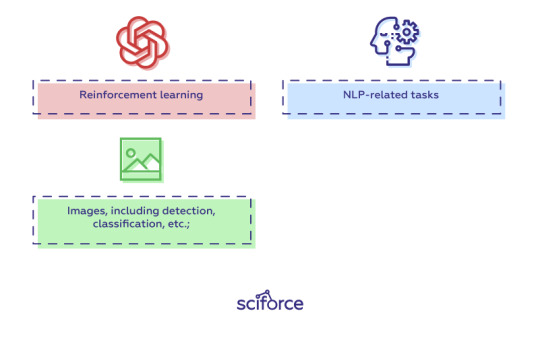
Instead of predefined graphs with specific functionalities, PyTorch allows developers to build computational graphs on the go, and even change them during runtime. PyTorch provides Tensor computations and uses dynamic computation graphs. Autograd package of PyTorch, for instance, builds computation graphs from tensors and automatically computes gradients.
For inference, developers can export to ONNX, then optimize and deploy with NVIDIA TensorRT.
The drawback of PyTorch is the dependence of its installation process on the operating system, the package you want to use to install PyTorch, the tool/language you’re working with, CUDA and others.
Learn more:
Learn How to Build Quick & Accurate Neural Networks using PyTorch — 4 Awesome Case Studies
PyTorch tutorials
Keras

Keras was created in 2014 by researcher François Chollet with an emphasis on ease of use through a unified and often abstracted API. It is an interface that can run on top of multiple frameworks such as MXNet, TensorFlow, Theano and Microsoft Cognitive Toolkit using a high-level Python API. Unlike TensorFlow, Keras is a high-level API that enables fast experimentation and quick results with minimum user actions.
Keras has multiple architectures for solving a wide variety of problems, the most popular are
image recognition, including image classification, object detection and face recognition;
NLP tasks, including chatbot creation
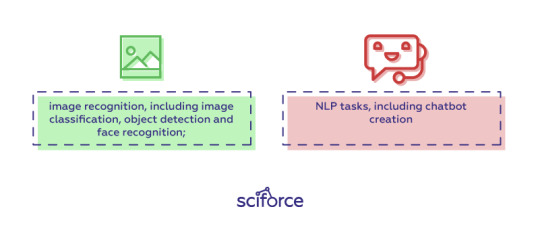
Keras models can be classified into two categories:
Sequential: The layers of the model are defined in a sequential manner, so when a deep learning model is trained, these layers are implemented sequentially.
Keras functional API: This is used for defining complex models, such as multi-output models or models with shared layers.
Keras is installed easily with just one line of code:
pip install keras
Learn more:
The Ultimate Beginner’s Guide to Deep Learning in Python
Keras Tutorial: Deep Learning in Python
Optimizing Neural Networks using Keras
Caffe

The Caffe deep learning framework created by Yangqing Jia at the University of California, Berkeley in 2014, and has led to forks like NVCaffe and new frameworks like Facebook’s Caffe2 (which is already merged with PyTorch). It is geared towards image processing and, unlike the previous frameworks, its support for recurrent networks and language modeling is not as great. However, Caffe shows the highest speed of processing and learning from images.
The pre-trained networks, models and weights that can be applied to solve deep learning problems collected in the Caffe Model Zoo framework work on the below tasks:
Simple regression
Large-scale visual classification
Siamese networks for image similarity
Speech and robotics applications
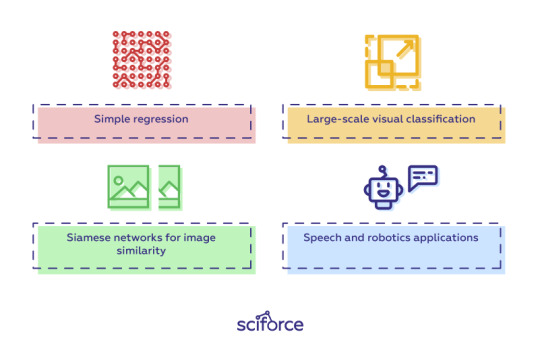
Besides, Caffe provides solid support for interfaces like C, C++, Python, MATLAB as well as the traditional command line.
To optimize and deploy models for inference, developers can leverage NVIDIA TensorRT’s built-in Caffe model importer.
The installation process for Caffe is rather complicated and requires performing a number of steps and meeting such requirements, as having CUDA, BLAF and Boost. The complete guide for installation of Caffe can be found here.
Learn more:
Caffe Tutorial
Choosing a deep learning framework
You can choose a framework based on many factors you find important: the task you are going to perform, the language of your project, or your confidence and skillset. However, there are a number of features any good deep learning framework should have:
Optimization for performance
Clarity and ease of understanding and coding
Good community support
Parallelization of processes to reduce computations
Automatic computation of gradients
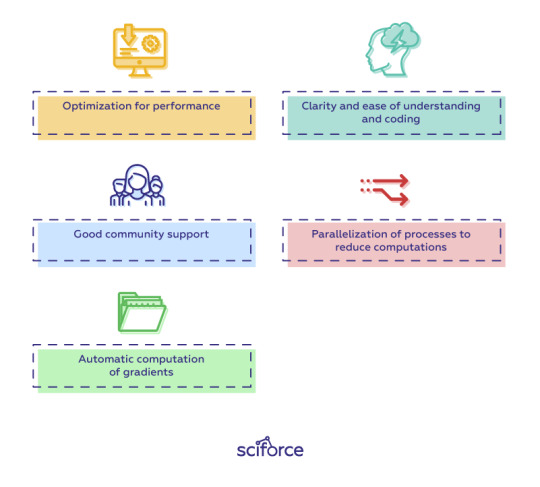
Model migration between deep learning frameworks
In real life, it sometimes happens that you build and train a model using one framework, then re-train or deploy it for inference using a different framework. Enabling such interoperability makes it possible to get great ideas into production faster.
The Open Neural Network Exchange, or ONNX, is a format for deep learning models that allows developers to move models between frameworks. ONNX models are currently supported in Caffe2, Microsoft Cognitive Toolkit, MXNet, and PyTorch, and there are connectors for many other popular frameworks and libraries.
New deep learning frameworks are being created all the time, a reflection of the widespread adoption of neural networks by developers. It is always tempting to choose one of the most common one (even we offer you those that we find the best and the most popular). However, to achieve the best results, it is important to choose what is best for your project and be always curious and open to new frameworks.
10 notes
·
View notes
Text
Top 8 Python Libraries for Data Science

Python language is popular and most commonly used by developers in creating mobile apps, games and other applications. A Python library is nothing but a collection of functions and methods which helps in solving complex data science-related functions. Python also helps in saving an amount of time while completing specific tasks.
Python has more than 130,000 libraries that are intended for different uses. Like python imaging library is used for image manipulation whereas Tensorflow is used for the development of Deep Learning models using python.
There are multiple python libraries available for data science and some of them are already popular, remaining are improving day-by-day to reach their acceptance level by developers
Read: HOW TO SHAPE YOUR CAREER WITH DATA SCIENCE COURSE IN BANGALORE?
Here we are discussing some Python libraries which are used for Data Science:
1. Numpy
NumPy is the most popular library among developers working on data science. It is used for performing scientific computations like a random number, linear algebra and Fourier transformation. It can also be used for binary operations and for creating images. If you are in the field of Machine Learning or Data Science, you must have good knowledge of NumPy to process your real-time data sets. It is a perfect tool for basic and advanced array operations.
2. Pandas
PANDAS is an open-source library developed over Numpy and it contains Data Frame as its main data structure. It is used in high-performance data structures and analysis tools. With Data Frame, we can manage and store data from tables by performing manipulation over rows and columns. Panda library makes it easier for a developer to work with relational data. Panda offers fast, expressive and flexible data structures.
Translating complex data operations using mere one or two commands is one of the most powerful features of pandas and it also features time-series functionality.
3. Matplotlib
This is a two-dimensional plotting library of Python a programming language that is very famous among data scientists. Matplotlib is capable of producing data visualizations such as plots, bar charts, scatterplots, and non-Cartesian coordinate graphs.
It is one of the important plotting libraries’ useful in data science projects. This is one of the important library because of which Python can compete with scientific tools like MatLab or Mathematica.
4. SciPy
SciPy library is based on the NumPy concept to solve complex mathematical problems. It comes with multiple modules for statistics, integration, linear algebra and optimization. This library also allows data scientist and engineers to deal with image processing, signal processing, Fourier transforms etc.
If you are going to start your career in the data science field, SciPy will be very helpful to guide you for the whole numerical computations thing.
5. Scikit Learn
Scikit-Learn is open-sourced and most rapidly developing Python libraries. It is used as a tool for data analysis and data mining. Mainly it is used by developers and data scientists for classification, regression and clustering, stock pricing, image recognition, model selection and pre-processing, drug response, customer segmentation and many more.
6. TensorFlow
It is a popular python framework used in deep learning and machine learning and it is developed by Google. It is an open-source math library for mathematical computations. Tensorflow allows python developers to install computations to multiple CPU or GPU in desktop, or server without rewriting the code. Some popular Google products like Google Voice Search and Google Photos are built using the Tensorflow library.
7. Keras
Keras is one of the most expressive and flexible python libraries for research. It is considered as one of the coolest machine learning Python libraries offer the easiest mechanism for expressing neural networks and having all portable models. Keras is written in python and it has the ability to run on top of Theano and TensorFlow.
Compared to other Python libraries, Keras is a bit slow, as it creates a computational graph using the backend structure and then performs operations.
8. Seaborn
It is a data visualization library for a python based on Matplotlib is also integrated with pandas data structures. Seaborn offers a high-level interface for drawing statistical graphs. In simple words, Seaborn is an extension of Matplotlib with advanced features.
Matplotlib is used for basic plotting such as bars, pies, lines, scatter plots and Seaborn is used for a variety of visualization patterns with few syntaxes and less complexity.
With the development of data science and machine learning, Python data science libraries are also advancing day by day. If you are interested in learning python libraries in-depth, get NearLearn’s Best Python Training in Bangalore with real-time projects and live case studies. Other than python, we provide training on Data Science, Machine learning, Blockchain and React JS course. Contact us to get to know about our upcoming training batches and fees.
Call: +91-80-41700110
Mail: [email protected]
#Top Python Training in Bangalore#Best Python Course in Bangalore#Best Python Course Training in Bangalore#Best Python Training Course in Bangalore#Python Course Fees in Bangalore
1 note
·
View note
Text
Top 5 Python Libraries You Must Know
If there’s one dynamic programming language that taking the lead role in disruptive technology applications, it’s Python. One of the basic and important reasons for the programming language’s popularity is its code readability.
Python is increasingly finding applications in disruptive technologies such as data analytics, machine learning, and artificial intelligence. By learning and mastering the programming language, you can get an edge on your career.
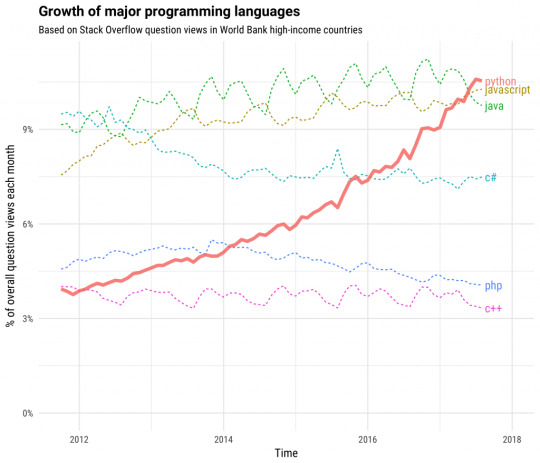
Credit: https://stackoverflow.blog/2017/09/06/incredible-growth-python/
Here are the top 5 python libraries:
Matplotlib
Matplotlib is a plotting library for python; it is extensively used for data visualisation as it is designed to produce graphs and plots. The object-oriented API of the library can be used to embed the plots into applications.
Matplotlib makes a great alternative to MATLAB. It is compatible with all types of operating systems as it supports several backends and output types.
Keras
Keras is one of the popular machine learning libraries in Python that eases graph visualisation, data-set processing, and model compiling. Keras is designed to allow ease of neural network expression.
One of the biggest advantages of using Keras is the python library runs smoothly on CPU as well as GPU. Also, Keras supports different types of neural network models, including fully connected, embedding, recurrent, pooling, and convolutional.
NumPy
NumPy is another popular machine learning library in Python. NumPy is one of the libraries TensorFlow uses in order to perform operations on Tensors. NumPy eases coding as therefore is beginner-friendly. Also, the interactive design of the library makes it easy to use.
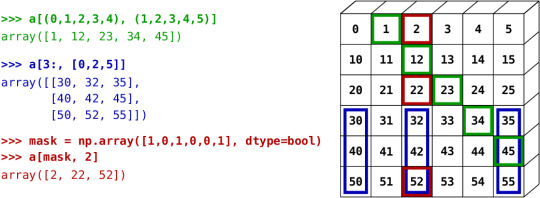
NumPy Array Object
Pandas
Pandas is the most popular data science library in python that is widely used for data analysis and cleaning. The library’s high-level abstraction makes it a popular choice. WIth Pandas, you can create your own function and run it on data sets.

Growth of Panda as per google search trends
Also, Pandas is highly suitable for time-series-specific functionality such as date shifting, linear regression, moving window, and date range generation. Finance and statistics are the two commercial areas where Pandas come to use.
Theano
Theano is a commonly-used computational framework machine learning library in Python. Theano is similar to TensorFlow in terms of functionality; it is widely used as a standard library for research and development for Deep Learning.
The library was initially designed for computation for large neural network algorithms. The rising number of multiple neural network projects has led to an increase in the popularity of the machine learning library.
Attend a bootcamp for data science and get an edge on your career Attend a data science bootcamp and understand the potential of the disruptive technology. Attending the bootcamp is also helpful for choosing the right programming languages that are used in disruptive technologies.
1 note
·
View note
Text
HOW TO BECOME A MACHINE LEARNING PRO IN 2023

To become a machine learning professional, you should start by gaining a solid understanding of the fundamental concepts and mathematical foundations of the field. This can be done through taking online courses, reading books and research papers, and practising with hands-on projects. Some key areas to focus on include:
Linear algebra and calculus
Probability and statistics
Programming
Specific machine learning algorithms
Deep learning
Read More: Become a Machine Learning Expert in 2023.
Once you have a strong foundation in these areas, you should continue to build your skills by working on projects and participating in machine learning competitions. It's also important to stay current with the latest advancements and research in the field.
Linear algebra and calculus
Linear algebra and calculus are both used extensively in machine learning. Linear algebra provides the mathematical foundation for many of the algorithms used in machine learning, such as matrix operations and eigendecompositions. Calculus is used for optimisation, which is a key component in many machine learning algorithms. For example, gradient descent, which is used to train many types of neural networks, relies heavily on calculus to adjust the model's parameters in order to minimize the error. Additionally, Calculus also helps in understanding the behaviour of functions and their local minima/maxima, which is useful in understanding the optimization techniques used in ML. Overall, Linear Algebra and Calculus are essential tools for understanding and implementing many machine learning algorithms.
Probability and statistics
Probability and statistics are fundamental concepts that are used extensively in machine learning. They are used to model and analyze data, make predictions, and evaluate the performance of machine learning models.
Probability is used to represent the uncertainty in data, which is often modelled using probability distributions. This is important for understanding and modelling the relationships between variables in the data, and for making predictions.
Statistics are used to summarize and describe the data, and to make inferences about the underlying population from a sample of data. This is important for understanding the characteristics of the data, and for selecting appropriate models and algorithms for the task at hand.
Probability and statistics are used for feature selection, feature engineering, and model selection. They also play a key role in evaluating and comparing the performance of different machine learning models. For example, hypothesis testing, p-value, Bayesian inference, Maximum Likelihood Estimation, etc are all statistical concepts used in ML.
Overall, probability and statistics are essential tools for understanding and working with data in machine learning, and for developing and evaluating machine learning models.
3. Programming
Programming is an essential tool for implementing machine learning algorithms and building machine learning systems. It allows data scientists and engineers to translate mathematical models and algorithms into working code that can be run on a computer.
In machine learning, programming is used to:
Collect, clean and prepare the data for modelling.
Implement and test different machine learning algorithms and models.
Train and fine-tune models using large datasets.
Evaluate the performance of models using metrics like accuracy and error.
Deploy machine learning models in production environments, such as web applications or mobile apps.
Popular programming languages used in machine learning include Python, R, Matlab, Java and C++. These languages have a wide range of libraries and frameworks that make it easy to implement machine learning algorithms, such as TensorFlow, scikit-learn, and Keras.
Overall, programming is a critical skill for anyone working in machine learning, as it allows them to implement and test the models they develop, and to build systems that can be used in real-world applications.
4. how do Specific machine learning algorithms help in learning machine learning?
Different machine learning algorithms have different strengths and weaknesses and are suited for different types of tasks and datasets. Some common examples include:
Linear regression and logistic regression are simple and easy to understand and are often used for basic prediction tasks.
Decision trees and random forests are powerful for classification and regression tasks and can handle non-linear relationships and missing data.
Support vector machines (SVMs) are effective for high-dimensional and non-linearly separable data.
Neural networks and deep learning are extremely powerful and flexible and are used for a wide range of tasks including image and speech recognition, natural language processing and more.
k-nearest neighbours is a simple algorithm that is used for classification and regression tasks.
Gradient Boosting Machine (GBM) is used for both classification and regression tasks and is a powerful algorithm for handling imbalanced and non-linearly separable data.
There are many other algorithms such as Naive Bayes, K-means, etc which are used for specific tasks.
In summary, different machine learning algorithms are well suited for different types of datasets and tasks, and choosing the right algorithm for a specific problem can make a big difference in the performance of a machine learning model.
Read More: Gain the best machine Learning Knowledge by NearLearn Blogs.
5. Deep learning
Deep learning is a subset of machine learning that uses artificial neural networks with multiple layers to learn and make predictions or decisions. These neural networks are inspired by the structure and function of the human brain and are used for tasks such as image and speech recognition, natural language processing, and decision-making. Deep learning algorithms can automatically learn features from large amounts of data, making them particularly useful for tasks where traditional rule-based approaches are not feasible.
0 notes
Text
How Can Future Outcomes be Predicted Using Historical Data?

Predictive analysis is a powerful tool that can help us predict future outcomes based on historical data. This type of analysis is essential in many different fields, as it can improve decision making and help businesses increase their profit rates while reducing risk.
What is Predictive Analysis? Predictive analytics uses data from existing data sets to identify new trends and patterns. We use trends and patterns to predict future outcomes and trends. By performing predictive analysis, we can predict future trends and performance. Predictive analytics can help you identify the probability of future outcomes based on historical data. By using data, statistical algorithms and machine learning techniques, you can get a better understanding of what might happen in the future.
Steps involved in Predictive Analysis i) Definition of Problem Statement: What are the project outcomes you're hoping for? What's the scope of the project? What are the objectives? Identifying the data sets that will be used is essential. ii) Data Collection The first step in predictive analysis is to collect data from an authorized source. This data can come from historical records or other sources. Once you have the necessary data, you can begin to perform predictive analysis. iii) Data Cleaning Data cleaning is the process of refining our data sets. In the data cleaning process, we remove unnecessary and erroneous data. This involves removing redundant and duplicate data from our data sets. iv) Data Analysis We explore data to identify patterns or new outcomes.We're in the process of discovery, learning useful information and identifying patterns or trends.. v) Build Predictive Model At this stage of predictive analysis, we use various algorithms to build predictive models based on the patterns observed. This requires knowledge of python, R, Statistics and MATLAB and so on. vi) Validation It's a crucial step in predictive analysis. We assess the model's accuracy by running various tests. We feed it different input sets to see if it produces valid results. vii) Deployment Deploying our model into a real environment helps us to use it in our everyday discussions and make it available for everyone. viii) Model Monitoring Make sure to keep an eye on your models' performance, and check that the results are accurate. This way, you can be sure that your predictions are on track.
Predictive Analytical Models We’ll now have a look at the models of Predictive Analysis. The different types of Predictive Analysis models are given below with relevant explanations. i) Decision Trees If you want to understand what leads to someone's decisions, then you may find decision trees useful. This type of model can help you see how different variables, like price or market capitalization, affect someone's decision-making. Just as the name implies, it looks like a tree with individual branches and leaves.
ii) Regression This model is really useful for statistical analysis. You can use it to find patterns in large sets of data, or to figure out the relationship between different inputs. Basically, it works by finding a formula that represents the relationship between all the inputs in the dataset.
iii) Neural Networks This model is really useful for statistical analysis. You can use it to find patterns in large sets of data, or to figure out the relationship between different inputs. Basically, it works by finding a formula that represents the relationship between all the inputs in the dataset.
Importance of Predictive Analysis As competition increases and the digital age brings profound changes, companies need to be one step ahead of the competition to stay ahead. Predictive analysis is like having a strategic vision of the future, mapping the opportunities and threats that the market has in store. This can give companies the edge they need to stay ahead of their competition. Companies are adopting predictive models to help them anticipate their customers' and employees' next moves, identify opportunities, prevent security breaches, optimize marketing strategies, and improve efficiency. Predictive modeling can help companies reduce risks and improve their overall operations.
Applications of Predictive Analysis i) Forecasting Forecasting is essential for manufacturers because it ensures the optimal utilization of resources in a supply chain. The supply chain wheel has many critical components, such as inventory management and the shop floor, which require accurate forecasts to function properly. ii) Credit When you apply for credit, lenders will look at your credit history and the credit records of other borrowers with similar characteristics to predict the risk that you might not be able to repay the debt. This process, called credit scoring, makes extensive use of predictive analytics. iii) Underwriting Insurance companies use data and predictive analytics to help them underwrite new policies. They look at factors like an applicant's risk pool and past events to determine how likely it is that they'll have to pay out a claim in the future. iv) Marketing As marketing professionals, we always look at how consumers are reacting to the economy when planning new campaigns. This helps us determine if the current mix of products will be appealing to consumers and encourage them to make a purchase.
Advantages of Predictive Analysis There are many advantages of Predictive Analysis. Some of them are listed below. i) Predictive analytics can help you improve your business strategies in many ways, including predictive modeling, decision analysis and optimization, transaction profiling, and predictive search. ii) It's been a key player in search advertising and recommendation engines, and can continue to help your business grow. iii) We hope these techniques can help with upselling, sales and revenue forecasting, manufacturing optimization, and even new product development.
Disadvantages of Predictive Analysis However, we should note that predictive analytics also has some disadvantages. i) If a company wants to make decisions based on data, it needs to have access to a lot of relevant data from different areas. ii) Sometimes it can be hard to find large data sets like this. iii) Even if a company has enough data, some people argue that computers and algorithms can't take into account things like the weather, people's moods, or relationships, which can all affect customer-purchasing patterns. iv) If you want to be good at predictive analytics, it'll help you to understand business forecasting, how and when to implement predictive methods in a technology management plan, and how to manage data scientists.
Conclusion Predictive Analysis, plays an important role in Business domains. In this article we discussed the definition of Predictive Analysis, and other parameters. Predictive Analysis is used in the concept of Machine Learning. Machine Learning requires strong fundamentals of the same. Data Science is the foundation of Machine Learning. Machine Learning Engineers are in demand by FAANG companies. The scope is abundant. Hence, Data Science as a course is a necessity. At Skillslash, candidates who are enrolled, are taught Data Science. By signing up at SkillSlash’s Data Science Course In Surat , candidates get an opportunity to work in live projects with top startups. Also, there's the chance to receive direct company certification for these projects. Get personalized training and 1:1 mentorship by enrolling in the platform. Skillslash Full Stack Developer Course In Bangalore and Data Structures and Algorithms Course. Apart from these, they offer a guaranteed job referral program. Get in touch with the student support team to know more.
0 notes
Photo

Get help for any Matlab Programming assignment or project from top industry experts. We guarantee accurate and excellent solutions for MATLAB Image Processing, Matlab Programming, Matlab Simulation, Matlab Signal Processing, #FFT, #Matlab Neural Networks and more.We deliver urgent Matlab Programming on top priority.
Visit our website: https://assignmenthelpforme.com/matlab-programming-assignment-help/
Email: [email protected] Telegram: @urgenthomework
#matlabassignmenthelp#matlabprogramming#matlabsimulation#matlabimageprocessing#matlabsignalprocessing#FFT#matlabneuralnetworks
0 notes
Text
Why Data Scientist Remains As The Top Job In Malaysia?
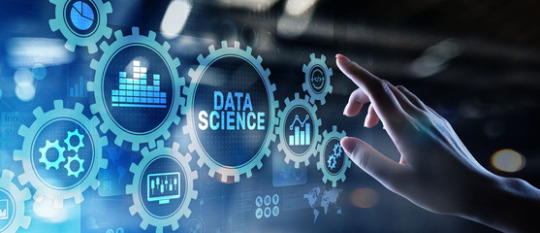
Data science is all about being inquisitive – asking new questions, making new discoveries, and studying new issues. Ask data scientists most obsessed with their work what drives them of their job, and they will not say “cash”. The actual motivator is having the ability to use their creativity and ingenuity to solve hard problems and constantly indulge of their curiosity. Data Science or Data Analytics is a mix of various instruments, algorithms, and machine learning ideas with the aim to find hidden patterns from the raw data. While a Data Scientist not only does the exploratory evaluation to discover insights from it, but additionally makes use of varied superior machine studying algorithms to seek out the prevalence of a particular occasion sooner or later.
Oh to stay in a generation where expertise and humans meet; is certainly the revolution people want. Choose from programs specifically curated to go well with each skilled’s training needs. Additionally, during the mentorship session, if the mentor feels that you simply require extra help, you may be referred to another mentor or coach. In this blended program, you'll be attending 48 hours of classroom sessions over six days on campus in Kuala Lumpur, Malaysia. After completion, you'll have entry to the online Learning Management System for an additional three months for recorded videos and assignments. As a Data Scientist, you may be constructing algorithms to solve enterprise issues using statistical tools similar to Python, R, SAS, STATA, Matlab, Minitab, KNIME, Weka, and so on.
find the hidden pattern or connection to be able to provide you with breakthrough insights that will contribute to our comfort, especially in the enterprise. From there, analysts and business people might be producing the insights to create a tangible business value. extracting clear data from uncooked information for the planning of actionable insights.
The 5 most wanted digital abilities are Big Data, software program and user testing, Mobile Development, Cloud Computing, and software engineering administration. Being in Sabah made it difficult for me to survey the schools in Peninsula. I discovered 360digitmgonline and so they offered detailed information & helped me with my utility. Xavier Phang, Software Engineering Graduate from Asia Pacific University Some private universities in Malaysia offer data science degrees, which is an obvious selection. This degree will provide you with the mandatory abilities to course of and analyze a complex set of knowledge, and can involve a lot of technical data associated to statistics, computer systems, evaluation strategies, and more. Most information science programs may even have a artistic and analytical factor, allowing you to make judgment selections primarily based on your findings.
It turned out to be extremely powerful engaged on something I was keen about. It was easy to work exhausting and study nonstop as a result of predicting the market was something I really needed to accomplish. Overall, the project should be the main focus, and courses and books ought to complement that. Although this series only runs once every a number of months, when you’re new to Computer Science and Python, this is a nice collection to leap into when you get the possibility. I found the lecturers enthusiastic about what they train, making it a pleasant expertise taking the courses.
The college students will discover the varied stages of the Data Science Lifecycle in the trajectory of this course. Initially conceptualize Data preparation, Data Cleansing, Exploratory Data Analysis, and Data Mining . Progressively study the theory behind Feature Engineering, Feature Extraction, and Feature Selection. Build machine learning, Deep Learning, and Neural Network algorithms with Python and R language.
The firms hiring a gaggle of individuals with some mounted set of expertise that are wanted right now will not be wanted 5 to 10 years from now. The firms need an individual who can analyze the data and put together it to be used in an economical method. 360digitmghelped me to find an affordable and yet world top ranked computer science college. Deriving advanced reads from data is past just making an statement, it is about uncovering “reality” that lies hidden beneath the surface. Problem solving isn't a task, but an intellectually-stimulating journey to a solution.
Data science is an unlimited, interesting, and rewarding field to check and be a part of. You’ll want many abilities, a wide range of information, and a passion for knowledge to become an effective information scientist that firms wish to rent, and it’ll take longer than the hyped-up YouTube videos declare. This is among the most extremely rated courses devoted to the specific arithmetic used in ML. Take this course when you’re uncomfortable with the linear algebra and calculus required for machine learning, and also you’ll save some time over different, more generic math courses. Created by Andrew Ng, maker of the famous Stanford Machine Learning course, this is likely one of the highest-rated data science programs on the internet.
Learn about the Perceptron algorithm and Multi-layered Perceptron algorithm or MLP. Understand Kernel tips used inside Support Vector Machine algorithms. Understand linearly separable boundaries as well as non-linear boundaries and now to solve these utilizing Deep learning algorithms. Understand one of many key inferential statistical techniques known as Hypothesis testing. Learn in regards to the implementation of a Regression methodology based on the business issues to be solved.
Once you full the coaching, assignments, and stay initiatives, we will send your resume to the organizations with whom we now have formal agreements on job placements. 360DigiTMG offers internship alternatives by way of Innodatatics, our USA-based consulting partner, for deserving participants to assist them to acquire actual-life experience. With growing demand, there is a shortage of Data Science/Business Analytics professionals out there.
Explore more on -Data Science Training in Malaysia
INNODATATICS SDN BHD (1265527-M)
360DigiTMG - Data Science, IR 4.0, AI, Machine Learning Training in Malaysia
Level 16, 1 Sentral, Jalan Stesen Sentral 5, KL Sentral, 50740, Kuala Lumpur, Malaysia.
+ 601 9383 1378 / + 603 2092 9488
Hours: Sunday - Saturday 7 AM - 11 PM
#data scientist course#data science course in malaysia#data scientist course in malaysia#data scientist training in malaysia#data scientist certification malaysia
0 notes